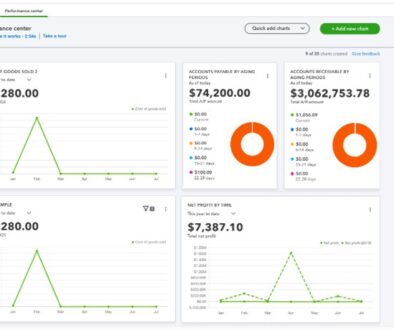Protecting your retail business for the future with the changing times
Bob Dylan, the 2016 Nobel Prize in Literature winner, songwriter, and singer, wrote a song called The Times They are a-Changin’ (1964). In 2020, U.S. retail businesses began experiencing changing times. Which of these retail business changes are only relevant during the COVID-19 pandemic, and which changes will continue to define the retail industry’s future?
More specifically, how does Ability Financial Exchange for QuickBooks Online (AFE) from Ability Business let you accomplish your work remotely to deal with retail changes from COVID-19?
Ability Financial Exchange Connects POS with QuickBooks Online
When you’re using QuickBooks Point of Sale Desktop, Ability Financial Exchange for QuickBooks Online lets you sync point of sale with QuickBooks Online accounting software in near real-time. AFE syncs to cloud-based QBO in near real-time instead of syncing with on-premises QuickBooks Desktop accounting software at end-of-day.
Which COVID-19 Changes Affect Retail Businesses?
Retail Changes During the COVID-19 Pandemic
During the pandemic, COVID-19 changes affecting retail businesses include:
- Demand changes
- Cash flow problems
- Increased online sales through eCommerce channels, with delivery or pickup options
- Temporary store shutdowns (closing)
- Number of in-store shoppers (capacity limit restrictions)
- Supply chain problems
Challenges relating to COVID-19 include unanticipated changes in demand patterns and reduced visibility for forecasting sales levels by stock-keeping unit (SKU). These demand uncertainties and sales declines impact:
- Forecasting merchandise sales and purchase orders
- Price reductions to make customer sales, and
- Accounting for obsolete inventory and slow-moving inventory
- Cash flow management
Due to shopper stockpiling, some retailers like Costco, Walmart, and Target, have experienced significant increases in online shopping demand during the COVID-19 pandemic.
Navigating their changing demand issues includes:
- Uncertainty in forecasting merchandise orders
- Experiencing stockouts
- Locating products in the supply chain and different warehouse locations, and
- Logistics and backorder delays in receiving the merchandise.
Based on CDC guidelines, state and local regulations mandate temporary retail store shutdowns and general lockdowns during COVID-19 hospitalization and ICU usage peaks. In less severe stages of community COVID-19 infection rates, stores may be required to limit the number of customers allowed inside to shop. At these times, customers wait in a socially-distanced line to enter the store.
Retailers may still be stocking goods for which demand has lessened. For example, customers that are employed aren’t buying business clothes when they work remotely from home. Instead, they’re buying athletic and leisurewear. Customers experiencing layoffs due to pandemic economic impacts don’t have the same shopping budget as they did pre-pandemic.
Managing cash flow is always essential, but its importance is magnified in pandemic times. Changing demand patterns and long lead-times to receive back-ordered merchandise to make sales leads to cash shortfalls that need to be covered by financing.
U.S. Federal Government stimulus, including the Paycheck Protection Program (PPP) business loans program, can help bridge the financing and cash-flow gap. To apply, businesses need to have a good grasp of their cash flow status and financial statements.
If financing is unavailable to your business, cash shortfalls can mean the difference between survival and financial distress. Inadequate cash can lead to the sale of a company to other businesses or investment firms with more substantial cash positions, or to bankruptcy.
COVID-19 Challenges Requiring Retailer Creativity
- Serving customers in physical store locations during COVID-19
- Increasing sales through new channels, including online sales or eCommerce
- Attracting customers in new ways to create new revenue streams
- Overcoming economic strains and stress from reduced business levels
Besides changes like online ordering with curbside or in-store pickup or delivery, retailers have begun thinking about new ways to create revenue streams. Retailers may let customers exclusively reserve time slots for shopping in a store. Physical brick-and-mortar retail stores have become omnichannel, letting customers choose to use eCommerce shopping. Butcher shops may add online retail delivery channels to their regular wholesale delivery routes for restaurants.
With retail creativity, displaced revenue can be replaced to some extent. Stimulus financing, like the PPP program or your available sources, can help relieve some of the economic strains and stress from business sales reductions. Adding multichannel sales and keeping track of cash flow in real-time to find timely solutions will also help reduce cash shortfalls and elevated stress levels.
Continuing COVID-19 Impacts that May Change the Future of Retailing
COVID-19 changes that will continue into the future include:
- Substantial increase in online shopping (omnichannel business model)
- Shift to remote work, facilitated by cloud software and collaboration platforms
- Logistical capacity challenges and technology changes
The increase in online shopping during the COVID-19 coronavirus pandemic will continue into the future. Retailers need to build a multichannel strategy to reach customers where they want to shop to capture revenue. According to Accenture, retailers are facing COVID-19 changes and can incorporate “data-driven insights” from AI technology platforms to personalize offers to customers online.
Working from remote locations, when possible, is a shift that will continue to impact retailing. Cloud-based software allows some work to be performed on different computing devices, including mobile, with the convenience of access at any time.
With the continuing shift to online shopping and predicted demand increases upon economic recovery in the future, logistics capabilities must ramp up to meet the increase in orders by retailers. Logistics includes supplier and distributor warehouse capacity for order fulfillment and delivery vehicle fleet utilization and expansion.
Climate change is now in focus, and mitigation technology will continue to expand. Using hydrogen-powered forklifts (from Plug Power) in warehouses is more efficient, eliminating long battery recharging times, and improving delivery time. Amazon and Walmart use this type of forklift in distribution centers. The use of hydrogen-powered vehicles will extend to long-haul semi-trucks, last-mile delivery, and airport logistics vehicles.
The introduction of EV, hybrid, and hydrogen-fueled freight vehicles for deliveries during the next decade will help meet growing climate-change demands by retailers from their supply chains. Self-driving semi-trailer trucks will reduce costs and increase efficiency for logistics companies. Drone deliveries will be added to the mix for increased delivery efficiency in rural areas.
If cost savings are passed on to retailers, then delivery costs may increase by a lower amount than otherwise expected. Reducing logistics costs is essential if retailers pay for shipping customer online sales items when they spend the required amount for free shipping.
Our next section focuses on a solution for the switch to more remote work that will continue post-pandemic.
How Does Using Cloud-Based Software Help You Work Remotely?
Brick-and-mortar retailers with QuickBooks Point of Sale Desktop operations can use Ability Financial Exchange (AFE) cloud software any time to allow them to perform some work remotely from their computer or a mobile device with an iOS, iPadOS, or Android operating system.
To gain the benefits of using cloud QBO software, you’ll need AFE integrated add-on software for syncing QuickBooks Point of Sale with QuickBooks Online. QuickBooks POS only provides syncing to on-premises QuickBooks Desktop accounting software as part of the End-of-Day procedure.
Cloud-based Ability Financial Exchange for QuickBooks Online provides two-directional syncing in almost real-time between QuickBooks Point of Sale Desktop and QuickBooks Online. With AFE for QBO, retailers can work from either QuickBooks Online or QuickBooks Point of Sale Desktop to complete applicable tasks from the most convenient location.
Ability Financial Exchange is a scalable software solution that works with multiple retail registers and store locations, plus Ecommerce with Webgility software integration. AFE handles your current level of business operations and future growth.
Which Retail Tasks Can You Accomplish with QuickBooks Online?
QuickBooks Online from Intuit is accounting software. QBO handles invoicing, accounts receivable, accepting payments for receivables from customers with online invoice Pay Now links or other methods, purchasing, accounts payable, cash flow management, reporting, and financial statements.
As a retailer, when you exchange data between QuickBooks Point of Sale and QuickBooks Online and sync, you can perform these accounting tasks from QuickBooks Online. (And you can complete them from anywhere, anytime with cloud-based software.)
QuickBooks Point of Sale Desktop optionally integrates with Webgility. Webgility enables using eCommerce platforms and marketplaces to become an omnichannel retailer. Ability Business, the developer of Ability Financial Exchange (AFE) for QuickBooks Online, has omnichannel expertise. Ability Business provides an end-to-end solution with Webgility.
QuickBooks POS then handles both in-store and online sales transactions and reports them separately. Real-time inventory status is available for viewing item availability, considering inventory transaction activity in all retail sales channels.
Summary – The Future of Retailing in Changing Times
The future of retailing is changing. This article describes how COVID-19 affects the retail industry and impacts its future.
Retail changes due to COVID-19 include:
- Demand changes
- Cash flow problems
- Increased online sales through eCommerce channels, with delivery or pickup options
- Temporary store shutdowns (closing)
- Number of in-store shoppers (capacity limit restrictions)
- Supply chain problems
COVID-19 changes that will continue into the future include:
- Substantial increase in online shopping (omnichannel business model)
- Shift to remote work, facilitated by cloud software and collaboration platforms
- Logistical capacity challenges and technology changes
Technologies that will be in high demand in retailing post-COVID are:
- Cloud-based technologies that enable remote work
- Software platforms that enable retail eCommerce
- AI-based retail tech that analyzes customer data and offers personalization
- Technologies that improve logistics capabilities and reduce costs
- Technologies that mitigate the effects of climate change.
With its Ability Financial Exchange sync software for QuickBooks Point of Sale and QuickBooks Online, Ability Business lets retailers respond to changing times resulting from COVID-19.
Ability Financial Exchange for QuickBooks Online is add-on cloud-based sync software that integrates with QBO. AFE lets you exchange data with QuickBooks POS and QuickBooks Online in near real-time. QuickBooks Point of Sale Desktop only lets retailers sync data with QuickBooks Desktop accounting software at End of Day.
QuickBooks Point of Sale Desktop offers integration with Webgility software to enable eCommerce online sales. That makes it easy for brick-and-mortar retailers to become omnichannel retailers. QuickBooks Point of Sale will track store and online sales separately to evaluate sales channel performance.
With QuickBooks Online accounting software synced to QuickBooks POS, you can perform some essential tasks remotely from home on your computer or anywhere using a mobile device.
QuickBooks Online can be used for:
- Assessing sales and inventory status
- Invoicing
- Accounts receivable and collections
- Purchasing
- Accounts payable
- Cash flow management
- Reporting
- Financial Statements.
The Times They are a-Changin’. Some of these changes arose during the COVID-19 pandemic. And some of these changes will continue. As a retailer, you need to change too to keep up with the future of retailing. Manage the challenges that COVID-19 presents to the retail industry now and in the future.

Barbara Cook
About the Author
Barbara is currently a financial writer working with successful B2B businesses, including SaaS companies. She is a former CFO for fast-growing tech companies and has Deloitte audit experience. Barbara has an MBA degree from The University of Texas and an active CPA license. When she’s not writing, Barbara likes to research public companies and play social games including Texas hold ‘em poker, bridge, and Mah Jongg.





